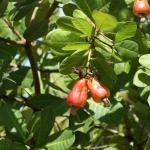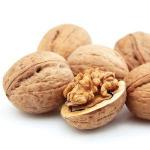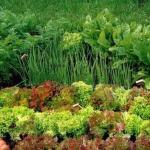It is quite common in the southern regions of our country. It is also found in the middle zone. The most valuable are frost-resistant varieties that produce high yields and have better quality fruits. Growing this crop is very profitable, because one walnut tree can provide the necessary amount of fruit for a whole year.
Appearance
The walnut is a tall tree with a spreading crown, the branches are located almost at right angles. The mighty straight trunk, covered with light gray bark, can reach 2 meters in diameter. The tree of the nut family has a fairly developed root system, which extends around 20 m. In adulthood, when the plant is 80 years old, the roots reach a depth of up to 12 m.
The complex-shaped leaves consist of five or even nine elongated leaves and have a peculiar smell. During flowering, which usually occurs at the beginning of May, the walnut tree looks very impressive. Male flowers of a greenish tint are collected in thick earrings, and female flowers are placed on the tops of branches, 2-3 pieces each.
It begins to bear fruit in the 12th year of life. The largest harvest is produced by a tree aged 50 years - up to 250 kg of nuts. The round-shaped fruits ripen in August and weigh from 8 to 12 grams, depending on the variety and place of growth.
How to grow a tree from a nut
This is the most common way to grow a walnut tree. The fruits selected for this purpose are strong, with a thin shell and a tasty kernel. Nuts intended for spring planting need to be properly dried. To do this, they are first laid out in the sun, and then dried in a shaded place. It is not recommended to dry fruits near radiators.

Planting is carried out immediately in a permanent place, since the root of the tree quickly reaches a certain depth and its injury during replanting can lead to the death of the plant. For planting, a fairly deep hole is dug - 1 m in depth and the same in diameter. It is filled with a soil mixture with rotted humus, thus creating a supply of nutrients for the future tree. The seeds are placed in the groove with the seam up to a depth of 15-20 cm, 3-4 pieces per hole.
Planting seedlings
Walnut seedlings take root best if planted in the spring. This must be done very carefully so as not to damage the lateral roots. The tap root must be cut at a depth of 40 cm using pruning shears, covering the cut area with clay. The planting hole must be at least 60 cm deep. A layer of fertilizer consisting of 150 g of superphosphate, 10 kg of humus and 50 g is poured into the bottom of the hole. A peg 1.5 m high must be installed in the hole to tie the plant in the first months after planting. Walnut seedlings are installed so that the root collar rises slightly above the ground. Then the lateral roots are carefully straightened and covered with earth mixed with 1 kg of lime. After planting the seedling, the soil near it must be watered and mulched abundantly. When planting several plants, the distance between them is 8-10 m.

Tree care
The young tree requires special attention in the first year of life. Regular watering, weeding and loosening are the main tasks for caring for it. Starting from the second year, they begin to form the crown; this process is completed by the time of fruiting. Pruning should be done very carefully, always treating the wounds. It is also necessary to periodically monitor the health of the plant: remove diseased or broken branches in a timely manner, and burn fallen leaves in the fall. In the spring, shortly before the buds open, you can spray the tree with Bordeaux mixture to protect against diseases.
However, the walnut tree does not tolerate excessive soil moisture. Therefore, when watering, you should take into account both the soil characteristics and the amount of precipitation.
Protection from diseases
The main disease to which the walnut tree is susceptible is the fungal disease marsoniosis, or brown spot. Plants are especially susceptible to it during the rainy season. A good way to combat this disease is to spray with fungicides, but doing this regularly if the tree is large enough is very difficult. To treat young trees, Bordeaux mixture or modern preparations sold in specialized stores are used. Spraying is carried out in two stages: before the buds begin to bloom and when signs of brown spot appear, the procedure is repeated after 25 days.

Benefits of walnuts
Nuts are considered an extremely valuable product, containing many nutrients. Their main area of application is the confectionery production and food industry. It is very useful to eat nuts in the winter season, when a large amount of energy is consumed. For people after serious illnesses, as well as for children who are stunted, nuts in combination with honey are recommended as a restorative nutrition.
Walnuts have long been famous for their medicinal properties. A mixture of crushed fruits and figs was used in ancient times as an antidote. is an excellent remedy for healing wounds and old ulcers; it is also used to treat conjunctivitis and inflammation of the middle ear. The ability of nuts to improve digestion makes them a real dietary product.

The leaves, which have insecticidal properties, secrete substances that are not tolerated by mosquitoes, midges, flies and other insects. Therefore, walnut trees can often be found not only on personal plots, but also in city gardens, squares, and near houses.
Many people on the planet have probably tried the amazingly delicious cashew nuts. But few people imagine how they are born and what the tree on which they grow actually looks like. The scientific name of the plant is Cashew (Anacardium, Indian nut). This tree is native to Brazil. Cashews love light and soil containing a high percentage of nutrients with good drainage. The maximum height that cashews reach is thirty meters. This plant can safely be classified as a long-livers; it can reach the age of one hundred years. Cashews are planted with seeds.
As already noted, in the natural environment for this tree, it can reach a height of 30 meters. In other conditions, 13-15 meters. Cashew is an evergreen plant with a short trunk and branches located quite low. Indian walnut is the proud owner of a thick, spreading crown with a diameter of 11-13 meters.
Cashew leaves may appear artificial and plastic in appearance. They are oval or egg shaped, very dense, leathery. Their length reaches twenty-two centimeters, 15 centimeters width.

Cashew inflorescences can hardly be called beautiful. The flowers are pale, greenish-pink in color, small, consisting of 5 thin petals with sharp tips, collected in the likeness of a panicle. The flowering of Indian walnut can be called long-lasting (several weeks), the reason is that the flowers do not bloom all at once, but one by one. Depending on climatic conditions, cashews can bloom up to three times a year; this tree alternates periods of dormancy, vegetation and growth.
Cashew nuts
It is worth taking a closer look at the description of the Indian nut fruit. Externally, the fruit looks like a yellow or red bell pepper. The size of the fruit is quite large, the stalk is oval or pear-shaped, from six to twelve centimeters long. Under the stalk there is fibrous pulp - yellow, very juicy with a sour taste, slightly astringent to the mouth. This fruit formation is called a pseudofruit or cashew apple. Countries engaged in the cultivation of Indian nuts collect about twenty-five thousand tons of such pseudo-fruits per year. They are suitable for food, they make excellent alcoholic drinks, delicious preserves, jams, juices and compotes. But that same famous cashew nut is located at the end of the stalk or pseudo-fruit.
The appearance of the nut resembles a comma or a small boxing glove. The fruit is hidden under a double protection of the shell, the outer green and smooth, the inner rough. Just under these shells is the nut itself; its average weight is one and a half grams.

As stated above, the Indian nut comes from Brazil. There, the cultivation of this fruit tree has been practiced since time immemorial. Cashews are now grown in about thirty-two countries around the world where tropical climates prevail.
Cashew is easy to care for. The main thing is warmth and nutritious well-drained soil. Loves sun and light, but can also grow in partial shade. It survives drought and high temperatures well, but does not like cold and frost.
The cashew plant is popular in many countries, largely because of its fruit. The peculiarity of cashew nuts is that they are sold exclusively without shells. Because it is poisonous due to the content between the outer shell and the core of phenolic resin, which causes burns when it comes into contact with human skin. That is why, before nuts go on sale, the shells are removed and high-quality processing is carried out to ensure that the toxic oil completely disappears.

The fruits from the tree are collected after they are fully ripened. The process is absolutely simple: the ripe fruit is picked from the tree, the nut is separated from the pseudo-fruit, dried in the sun, then fried on metal sheets, after which the shell is carefully removed.
Uses of cashew nuts
Cashew is a very healthy thing; it contains minerals. It is eaten both raw and fried, and is actively used in cooking. Indian nuts are an excellent addition to first and second courses, appetizers and salads, and they are also added to baked goods. It also produces wonderful oil, in no way inferior to peanut butter. Roasted nuts have a sweetish, pleasant taste. When frying, salt is added to preserve the aroma.
Cashew nuts are truly unique: they are even used for medicinal purposes (they treat anemia, psoriasis, dystrophy, and strengthen the immune system). According to its composition, the Indian nut is a storehouse of essential nutrients. It contains proteins, starch, carbohydrates, vitamins, minerals, fats, natural sugars, Omega-3 fatty acids. If you eat cashew nuts in moderation and daily, your body will be enriched with all the necessary substances. Cashews have a high calorie content: 630 kcal per 100 grams of product.

The downside of cashews is that this product can cause allergies. Therefore, people prone to it should eat these nuts with special care. Main symptoms: itching, nausea, swelling, vomiting.
Nowadays, there is a huge selection of cashews on sale: roasted and unroasted nuts, whole and split. What should you pay attention to first? Of course, on the appearance of the product and its smell. Naturally, there is no need to buy nuts that are not marketable. They should be nice, smooth, and free of foreign odors. There are several nuances: this way, whole nuts are stored much longer than crushed ones (six months in the refrigerator, a year in the freezer). If the nut is kept warm for a long time, it becomes bitter and may even germinate.
A fair question arises: is it possible to grow such a useful curiosity at home? The answer is definitely yes. But you will have to tinker: you need to create conditions for the tree that are close to tropical: warm and humid. As noted above, cashews reproduce by seeds, which must first be germinated, for which they must be placed in a container with water for two days. An important point is that the water with the seeds should be changed twice a day, because poisonous juice seeps out of them, turning the water blue. This procedure is done very carefully using gloves to avoid getting burned.
Pots for planting must be prepared in advance. The soil should not be heavy, on the contrary - nutritious and loose. One seed is planted in one pot. The first cashew shoots will appear in two to three weeks. The pots should be placed in a well-lit place, under the sun. It is imperative to monitor temperature conditions, control air humidity, and regularly spray and water the plant. It is recommended to use any universal fertilizer as a top dressing.

Cashews grow quite quickly, so in the first years after planting it is worth carrying out tree pruning procedures. With good proper care, cashews can begin to bear fruit in the second or third year of life. For the best yield, it is recommended to prune in the fall, leaving only the trunk and skeletal branches.
When the tree is harvested, all parts of the cashew nut are used for food. The nuts themselves undergo the necessary processing and are sent to various countries for sale. The pseudofruit is also used in the food industry. However, unlike the nut itself, it deteriorates very quickly due to the large amount of tannin it contains, so it cannot be transported. And you can taste this wonder only in countries where cashews directly grow.
In addition to nutritional value, this product also contains others: for example, in Africa it is used for tattooing, in Brazil as an aphrodisiac. Cashews are good for treating colds and stomach disorders. In addition, the oil extracted from the shell is used in the cosmetic and pharmaceutical industries. This product is also used to make varnish, drying oil, and rubber. Indian walnut wood is durable and resistant to rotting processes, for this reason it is actively used in shipbuilding and furniture production.
Cashews have been cultivated since ancient times by the Tinuka Indians, who lived in the territory of modern Brazil. They nicknamed the cashew "yellow fruit", which is obvious from its appearance.
In general, if you set a goal, then in a home greenhouse it is quite possible to grow a full-fledged cashew tree. The main thing is to provide it with proper care, atmosphere and care.
tree with nuts
Alternative descriptionsThe smell of wood from wines aged in new French oak barrels
Genus of coniferous evergreen trees of the pine family
Russian environmental movement
Coniferous tree feeding a man and a squirrel
Korean pine
nut tree
Coniferous, nut, oilseed
The novel by the Italian writer G. Deledda “Lebanese...”
This tree has long symbolized fertility and abundance, and the Bible says that King Solomon built his castle from it
Call sign Yuri Gagarin
Tree feeding a Siberian squirrel
Tree on the coat of arms of Lebanon
Coniferous Lebanese...
Gagarin's call sign
Tree with cones
Sumerian tree of life
Lebanon tree
Bonsai tree
Conifer tree
nut tree
Tree feeding a squirrel
Siberian pine
Coniferous Siberian...
Lebanese or Siberian
Siberian giant with Lilliputian nuts
Tree on the flag of Lebanon
The mighty taiga brother of the pine
Taiga handsome man with cones
Siberian antipode tropical. palm trees
A relative of the pine
. "coniferous" call sign of Yuri Gagarin
Taiga walnut tree
Taiga supplier of delicious nuts
Siberian giant with nuts - midget.
Siberian hazel
Squirrel nuts
Coniferous tree with tasty nuts
Coniferous tree of the Siberian taiga
Valuable coniferous tree
Taiga giant
Pine relative
Coniferous tree with large needles
What are cabinets made of to prevent moths from infesting them?
. "PP-91" Dragunov
Coniferous king of the Siberian taiga
His nuts go well with beer
Coniferous hazel
Tree that produces small nuts
Pine tree
Siberian giant with small nuts
Coniferous nut tree
Coniferous evergreen tree of the pine family
. "PP-91" Dragunov
. "Coniferous" call sign of Yuri Gagarin
Tree loved by squirrels
What are cabinets made of to prevent moths from getting into them?
M. is a coniferous tree that produces pine cones or nuts. Cedar of Lebanon, Pinus cedrus; Siberian, setbra, meleda, pine nuts, fun. Red cedar, cedar heather, Spanish juniper, Juniperus oxycedrus. In the extreme north-east. There is also cedar slate or birch. Cedar forest m. cedar forest. Kedrovik m. Sib. hazel grouse living in a cedar forest. Kedrovka nutcracker, crow bird, Nucifraga caryocataetes. Kedrovshchina arch. holiday of collecting pine cones, small fry
The novel by the Italian writer G. Deledda "Lebanese..."
Siberian giant with nuts - midget
Coniferous tree with nuts
Siberian giant with nuts - midget...
Taiga walnut tree
The mighty taiga brother of the pine
» Walnut
Walnut is one of the healthiest products on our table. Mentions of its various types are found in legends and epics, ancient manuscripts. Even ancient peoples noted that this product perfectly satisfies the feeling of hunger.. In addition, each fruit is enclosed in a shell, which allows it to be preserved for a long time and not spoil.
Each type of nut has its own advantages and disadvantages. The main advantage of any type of nut is their high calorie content and a large number of various vitamins included in their composition. Below is a list of the most popular nuts.
These fruits have practically no disadvantages. However, it is not recommended to give them in large quantities to children, and people suffering from food allergies should not eat nuts. Although it has not been established that these fruits can cause an allergic reaction, it can sometimes happen.
A nut is usually called the fruit of some types of fruit trees or shrubs, which consists of a kernel and a hard shell - the shell.

In botany, a nut is understood as a fruit that is indestructible, with a pericarp, inside of which there is a kernel or seed. Nuts include hazel, hazelnut.
There is also a whole family of Nuts, which look like nuts, but from a botanical point of view they are not nuts. But all other fruits that are called “nuts” are not.
The main varieties of nuts include:
- from the Nut family– walnuts, black, Manchurian, hazelnut, bitter;
- from the Berezov family– hazel, hazelnut, Turkish nut;
- from the Beech family- chestnut, plane tree, acorn.
There are other types of nuts, which will be discussed a little below.
Peanut

This groundnut belongs to the legume family. It is eaten much more often than almost all other types of these fruits.. During World War II in the United States, peanuts were one of the main products that helped solve the food problem in this country.
Peanuts contain the following substances and elements that are beneficial to the human body::
- antioxidants;
- chemical compounds that increase blood clotting;
- the fats contained in peanuts and products based on them do not contain “bad” cholesterol;
- Peanut oil contains polyunsaturated linoleic acid;
- It also contains vitamins E and B.

This nut consists of more than half fat, in addition, contains such macro and microelements: K, P, Fe, Mg, and vitamins A, B. And a couple of Brazil nuts contain the daily dose of selenium for an adult.
It is this nut that is recommended to be consumed to reduce the level of “bad” cholesterol in the blood, as well as normalize glucose levels. Children should eat it to grow better, and for the nervous ones – to put the nervous system in order. To give your body energy, it is enough to eat just one of these nuts.
In South America, couples are advised to eat Brazil nuts to improve their sexual functions.
water chestnut

This plant is an annual. The plant is attached to the bottom using last year's nuts. If the current becomes stronger, it tears off the stem of this nut and drags it along until the plant washes back into the shallow water. There the nut attaches to the bottom and begins to grow further.
This nut contains:
- flavonoids;
- tannins;
- triterpenoids;
- phenol compounds.
All parts of this aquatic plant are used in folk medicine. They are used in the treatment of dyspepsia, as a diuretic, and also as a sedative, diaphoretic and choleretic agent.
Fresh juice from the leaves helps in the treatment of certain eye diseases, as an antiseptic in the treatment of stinging insect or snake bites. This nut can also help relieve stress, helps strengthen the immune system, helps in the fight against viral infections.

This nut contains a large amount of polyunsaturated fatty acids, which are necessary for the fruitful functioning of the brain.
It also contains vitamins of groups A, B, E, C, as well as microelements such as Fe, Co, Zn, K, Mg, Ca, I, P.
Thanks to so many different elements and vitamins Walnuts are recommended to be eaten for anemia, it strengthens the immune system and lowers blood pressure. It should also be included in the diet of older people, pregnant women and breastfeeding mothers.

This nut is another healthy high-calorie product that it is advisable to have in your diet. But it should be remembered that due to their calorie content, nuts are best consumed separately from other foods.
Hazelnuts contain polyunsaturated fatty acids, various macro and microelements, vitamins B and E. These vitamins support the normal functioning of the central nervous system, help improve metabolism in the body, and prevent early aging of the body. Hazelnuts also contain vitamin C and nicotinic acid.
The fruits of this shrub should be eaten if you need to restore strength after a serious illness or surgery. A large number of useful substances contained in these nuts are helps cope with anemia, and additional vitamins are supplied to the internal organs.
By regularly eating hazelnuts, you can reduce the amount of “bad” cholesterol, reduce the risk of varicose veins, cleanse the liver of toxic substances, and remove decay products. In addition, these nuts have a calming effect on the nervous system, relieve anxiety, and improve sleep.

Although there are many varieties of chestnuts, sweet chestnuts are traditionally eaten. They are baked on coals– this delicacy has long been prepared in many countries around the world, especially at Christmas.
Chestnuts are not nuts, but due to their nutritional value they are classified as nuts such as walnuts.
Nutrients are found not only in fruits, but also in leaves, bark, and flowers. They contain glycosides, tannins, astragalus, carotenoids, steroids, vitamin C.

Almost all parts of pine nuts are useful- from kernels to shells, resins and needles. And they all have a unique set of mineral elements, vitamins and other beneficial substances, which together give Siberians health.
Fats, proteins and amino acids included in pine nuts are easily digestible, they promote the growth of the teenage body, are indispensable in the nutrition of pregnant women.
Cashew

Cashew nuts appeared on the shelves of our stores relatively recently, but have already gained popularity among customers. They are not only used in cooking, but also used in the treatment of a number of diseases..
These nuts are low in fat, but contain more fiber and carbohydrates than walnuts, for example. However, vitamins of groups B, E and P, as well as such chemical elements as Zn, Fe, Mg, Na, Ca, K, Mg, Cu, Se, help improve the functioning of many internal organs in our body. And Omega-3 saturated fatty acids are able to maintain the youth of the body, improve the condition of the skin, hair, and nails.
Pecan

This nut can perfectly replace animal proteins in the diet., it also contains useful macro and microelements, as well as antioxidants.
The presence of unsaturated fatty acids in pecans helps strengthen the cardiovascular system.
What is this nut rich in? It contains easily digestible fats, carbohydrates, thiamine, vitamin B6, Fe, Mg, P, K, Zn, Cu. Mg.
B vitamins allow you to improve the condition of your nails and hair, improve the condition of your skin. These vitamins also prevent muscle cramps and make tissue more elastic.
The substances that make up these nuts give a person a boost of energy, help fight cancer cells.

Pistachios are another type of nut that is beneficial for the human body. Found in their composition:
- oleic, palmitic, stearic amino acids;
- vitamins A, E, B, P;
- proteins, carbohydrates, starch;
- Cu, Mg, Mn, K, Fe, P.
These nuts satisfy hunger well and give energy, and also saturate the body with beneficial amino acids.
Macadamia

The trees on which these nuts appear can bear fruit for about a hundred years, and the yields do not decrease, despite the age of the tree. The fruits ripen for a long time - up to 7 months.
The fruits of this nut contain vitamins, chemical elements, various acids, dietary fiber, and unsaturated fatty acids.
These nuts have medicinal properties, helping with headaches, strengthening the walls of blood vessels, improving the condition of the skin, helping to restore strength, improves brain function, and removes “bad” cholesterol. And this is not a complete list of the beneficial properties of macadamia.
Conclusion
Any type of nut is very valuable for the human body.. Therefore, they should be included regularly in the diet. Moreover, you can eat each of the types separately, or several different nuts together.
Cedar is a majestic, powerful tree. The height of the cedar is 40-42 meters, the thickness of the trunk is up to 2 meters. The needles are long, 7-15 centimeters, dark green or bright green. Cedar lives up to 500 years. The cones are large, the size of a large goose egg, ripen in the second year and fall off along with the seeds (“pine nuts”). Ripe nuts can be obtained directly from the tree by birds (nutcrackers, crows), squirrels and chipmunks. The rest of the animals collect nuts on the ground after the cones fall. People collect pine seeds - “nuts” for future use; they are a very tasty delicacy. A healing infusion against scurvy is made from cedar needles. Cedar wood is light, durable, beautiful, and is used to make furniture. In addition, cedar wood can be easily cut in all directions, so it serves as a valuable raw material for the production of pencils.
The main advantage of Siberian cedar is its seeds (nuts). They are tasty, high in calories and easy to digest. Nuts have a very high content of proteins and fats, as well as vitamins A, B, E, F, as well as a high content of many essential microelements. 

The nutritional and healing properties of nuts are largely explained by the qualitative composition of fats, proteins, and other substances contained in them. The fat of pine nuts differs from other fats in its high content of polyunsaturated fatty acids, especially linoleic acid.




















